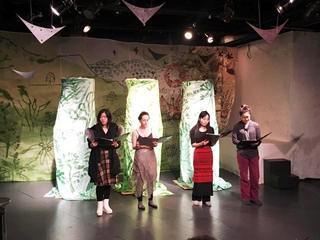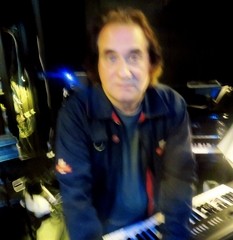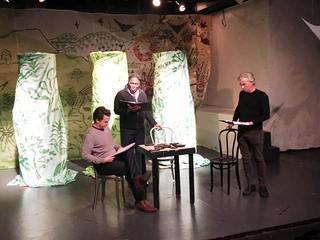|
Back
Many genocides ago... New York
Black Box Theater, Pless Hall
07/27/2017 - & July 28, 29, 2017
Keith Patchel: The Plain of Jars
Xi Yang (Laotian 4, Gaia), Clara Francesca (Laotian Girl, CIA Agent), Timothy McCown Reynolds (Richard Nixon), Robert Turner (John F. Kennedy), Sayaka Aiba (Laotian Girl, CIA Agent 2), Xi Yang, Jialin Li (Henry Kissinger), Chris Raddatz (Lyndon Johnson)
Alan Grubner (Violin), Cantata Fan (Pipa), Mars Band, Keith Patchel (Music Director, Producer, Keyboards & Electronics)
New York University IMPACT International Festival: Dr. John Gilbert, Alexis Kandra (Technical Operations, Set Design, Painter), Clayton Patterson (Images)

Y. Xi, C. Francesca, S. Aiba, J. Li (© Clayton Patterson)
“I feel her all the time now. At night I feel her breath passing in the darkness. I feel her in the ruined temples, the forlorn cities, the frightening woods. I feel her heart beating in complete and terrible wisdom.”
Frederic Prokosch, The Asiatics
“For days up there on the Plain of Jars I’d been trying to capture an image, find a metaphor, crystallize an idea that could convey what it means for Laos to have been one of the most heavily bombed nations in history and then to have gone on and somehow found a future. Finally, right there on a busy main street of Phonsavan, the provincial capital, I found it: a giant pile of bomb casings left over from the American bombing campaign in Laos, a stupendous and futile torrent of airborne destruction.”
T. D. Allman, from National Geographic Magazine
In the 35 years between Frederic Prokosch’s imaginary classic and T. D. Allman’s reportage on the Plain of Jars, Laos had turned from an Arcadian Indochinese Royal backwater to a hellhole nightmare where hundreds of B-52 sorties left Thailand’s secret airbases to destroy the Laotian areas bordering North Vietnam. This writer, enjoying opium-filled weekends on Vientiane, the raucous border town with Thailand, heard constant rumors about it–the bars and restaurants were filled with barely disguised CIA agents, with Corsican adventurers, Canadian folk singers, and one ex-Berkeley professor of philosophy running for President of the United States from his Vientiane home.
But a few adventurous journalists like Allman and Fred Branfman, whose book inspired The Plain of Jars, saw the devastation for itself, and the horror could never be erased.
Which is why, when I heard that about this opera written and composed by Keith Patchel, I wrote to Allman that making an opera out of (one of our) American holocausts was “a travesty.”
That was not entirely true. Mr. Patchel’s inspiration was from one of the greatest books of the Indochina War. (Not the “Vietnam” war. We bombed all three countries of the French colony). Fred Branfman’s Plain of Jars: Life Under An Air War was less the work of the late journalist than the words of the survivors on the Plain of Jars. Not only the words, but the drawings of the bombs, of their houses, the fields, the terrors.
And it was these drawings on three screens–with live superimposed shots of planes, explosions, some of the classic Vietnam photos–which gives this quasi-opera the most gripping moments. This videography, by Alexis Kandra and Mr. Patchel is constantly moving, changing, an almost hypnotic volition against three simulated giant jars, those pottery-mysteries of the eponymous Plain.

K. Patchel (© Samuel A. Dog)
This is not to belittle the music of this quasi-opera by Mr. Patchel. Actually, Plain of Jars had a variety of musical tools. The least impressive was a kind of ersatz-Asian overture. Not the Laotian bumptious khaen panpipe music, but a Dorothy Lamour Arcadian introduction to four Laotian girls singing of their simple happiness.
(I suppose the pipa sounds from Cantata Chen Fan were meant to give us Asia. But this admittedly snobbish old Asia hand was looking for something more authentic.)
The other scenes were predictable enough until the climax

J. L. Peacock, R. Turner, T. M. Reynolds (© Clayton Patterson)
Plotting, patriotism, sneakingly xenophobic stratagems to destroy Laos, by Kennedy, Nixon, Johnson and Kissinger (brilliant characterizations by Nixon-Reynolds and Raddatz-Johnson), spoken dialogue where Mr. Patchel’s sounds were like cartoon farts. A second White House scene, with a vicious Clara Francesca as a CIA agent ready to make Laos ready for democracy. All of it with the not-so-subtle symbolism of dominos on the table. (Remember the Domino Theory?)
For the opening of the second act, a touching ballet for two of the Lao villagers and Robert E. Turner (turning from Kennedy to a spirit to finally a kind of apotheosis of death.)
Mr. Patchel’s music was more background strumming here. Vaguely Asian, sometimes pentatonic, more often like film background music, where we heard the plotting and the mourning and–most important– were mesmerized by those screen collages of childish drawings and bombings.
That changed in the almost abrupt final scene, where the three Washington malefactors are taken by our Laotian village girls to their doom. (I won’t give away their prison, but it is a superb imagination which created this finale.)
Mr. Patchel left his finest music for the end, an anthem cum monodrama cum aria sung by the powerful operatic voice of Xi Yang. It is a long piece dealing with the loss of innocence, with purity, with the horrors of the American and invasion and somehow, the survival of the human spirit. And knowing that Mr. Patchel has taken a personal emotional tie with Laos–not only his visits but his celebration of President Obama’s contribution to clearing the left over ordinance and mines–gives a special aura to the opera.
Were these last solo minutes a bit too ungainly for the relatively short scenes before? Possibly, but perhaps it was essential to offer a truly dramatic scena to the competent but somewhat bloodless previous singing.
The work had its gripping moments to be certain. They were almost entirely visual, owing to the scenic design by Mr. Kandra. But the singing of the ladies and the spoken dialogue of the men were both impressive. And if the structure was somewhat simple, perhaps that was the only way Mr. Patchel could have brought the nightmare to reality.
Which was certainly more humane, more feeling than Mel Gibson’s black-humored nasty film Air America.
My own revulsion came walking back from the theater to my East Village home, where I started to count all the American Vietnams since that war. B-52s are antique war machines. Now we don’t even need real people to operate our de facto genocides. Drones in Pakistan, Afghanistan, Iraq, Syria, Yemen, flying out of countless clandestine air bases in the old Russian republics and throughout Asia and the Middle East, are our modes of bringing American values to the world.
Mr. Patchel has his future work cut out for him. Our American present hardly shows signs of even the simulacra of civilization. Hopefully he will resist depicting an Asian Arcadia which existed only in Mr. Prokosch’s novel, and portray the present war of the worlds which is insane and seems interminable.
Harry Rolnick
|